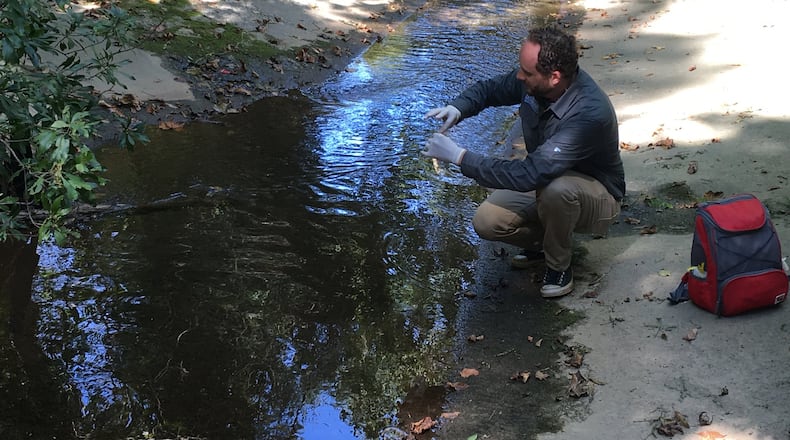A decade ago, the nine-mile Procter Creek, which runs through some of the city’s most historically impoverished communities, was one of the most polluted waterways in metro Atlanta. It flooded, was filled with trash and was an eyesore to residents in neighborhoods such as English Avenue and Vine City.
Across town, Tanyard Creek — which flows through Tanyard Creek Park in Buckhead — had problems as well. The water in the creek often changed color from black to white. Residents reported strange smells to city officials but were unable to get answers.
>> Related: Atlanta to pay $76K for water quality violations
So they reached out to Chattahoochee Riverkeeper (CRK) and began monitoring the water themselves. Each Thursday, Collier Hills resident Amanda Mayberry put on plastic gloves and went to the creek where she lowered a sterile sampling bag into the water with a PVC collection device and a line. Placing the samples on ice, she delivered them to CRK’s lab for analysis.
It would take many months to gather enough data but when CRK tracked down a sewage spill in the creek and reported it to the city, the problem was finally repaired. It marked the official beginning of the Chattahoochee Riverkeeper Neighborhood Water Watch Program (NWW), giving communities a path to engage and connect with their local waterways while also having a significant impact on water quality.
“It demonstrated how a non-profit could work with the community…to fill voids that were in place and get problems resolved,” said CRK riverkeeper, Jason Ulseth. With grants, the program has expanded to 175 sites where 110 citizen volunteers collect weekly or bi-weekly samples from the waterways connected to the Chattahoochee River, including three lakes and 42 creeks in metro Atlanta.
The program got its start almost a decade after a watershed moment in the turnaround of Atlanta’s waterways. In the late 1990s, the city signed a two-part consent decree agreeing to fix sewer overflows that had resulted in water pollution violations. The fixes, totaling about $3 to $4 billion, should have been completed in 2014, but that deadline was extended to 2027. In the meantime, citizen water monitors with NWW have filled the gaps by helping identify 75 sources of contaminants since the program began.
Proctor Creek begins in downtown Atlanta and flows northwest to the Chattahoochee River. It is currently the centerpiece of Proctor Creek Greenway, a revitalization that includes a seven-mile system of trails adjacent to the creek connecting the Atlanta Beltline to the Chattahoochee River. The Proctor Creek watershed still doesn't meet EPA standards, but it has become one of NWW's greatest success stories. After nearly a decade of monitoring under the NWW program, there has been a 79 percent reduction in E.coli levels in the Proctor Creek tributary at Greensferry near Washington Park — a decline from almost 500 times to 50 times the EPA standard. "It is no longer the most contaminated waterway in Atlanta," said Mike Meyer, NWW program director. "People are beginning to use the creek, and the water quality has improved."
Na’Taki Osborne Jelks, co-chair of the Proctor Creek Stewardship Council who has lived near the Proctor Creek watershed for 20 years, was a college student in the mid-1990s when she first began working with Carver Hill residents concerned about pollution in the creek. “We started multiple programs to get adults and kids out monitoring the streams,” Jelks said. The creek had once been an asset to the community — a place where they played, fished and were baptized — but they watched it decline as the city’s infrastructure lagged behind its growth and development.
When the community connected with NWW in 2010, their efforts began to gain more attention. “The Water Watch program took the potential that was already there and amplified it,” Jelks said. “There is very consistent monitoring that happens, but the other piece is Chattahoochee Riverkeeper has a good relationship with the city. They are able to share the data with the city, and (the city) pays attention to it.”
This year, the city has been paying attention to Utoy Creek in southwest Atlanta where NWW volunteers began sampling in 2012. Citizen water monitors have helped uncover six sewage spills in 2018. At the CFK lab, samples from Utoy Creek were mixed with a tagging agent and placed in an incubator at 35 degrees for at least 18 hours. The fluorescent blue color indicated elevated levels of E.coli. When the levels remained above 1000 CFU/100 ML (well above the EPA standard of 235 CFU/100 ML) for two weeks, Meyer jumped in the creek to track down the source.
Walking along a bracketed segment of South Utoy Creek, he discovered a pipe spewing untreated sewage into the water. A tree had been uprooted in a storm and pulled the line out. The city came out within 15 minutes and got it fixed, he said.
Sometimes the culprit is an illegal sewer line such as the recently discovered pipe that was depositing untreated sewage from West End Mall directly into Proctor Creek. Sometimes it is overflow from a system clogged with fats, oils and in recent years, flushable wipes.
Many of these spills would go unnoticed if not for the consistent monitoring of local citizens. “The biggest thing to understand about the program is we are creating data that is otherwise not being made available,” Ulseth said. “If we don’t get this consistent long-term monitoring, we don’t have anything to throw up red-flags when there is a problem.”
>> Related: Earth observations help Atlanta manage water, urban forests
But the program has also had an impact that goes beyond improving water quality. For some citizen monitors, NWW has given them purpose and a voice.
On a recent Thursday, Patti Ross dropped samples from Nancy Creek in Chastain Park to the CRK lab on Joseph Lowery Boulevard. “The first time I did it, I felt so good. My heart was soaring. I had just retired, and I felt like I actually did something,” said Ross.
That feeling of ownership is important, said John Carroll, distinguished professor of information sciences and technology at Penn State, who has examined how water monitoring data can be used in other ways. “We know that in some cases where things have gone horribly wrong that local people paid no role in minding the water,” he said. “One way to not find out in a catastrophic way would be to encourage this kind of activity.”
Darryl Haddock, an environmental scientist and executive director of West Atlanta Watershed Alliance, was among the early activists helping residents monitor Proctor Creek as part of Georgia’s Adopt-A-Stream program. He believes the Neighborhood Water Watch program has helped change the perception of residents along the Procter Creek watershed. “They are not seen as the angry community members. When you step in a room, elected officials look at you differently and treat you differently. You can say, ‘I collected this data, and I know what the values are that we are seeing,’” Haddock said. “You can hopefully create a new reality for community members by introducing them as researchers, co-partners and conveyors of a special set of information that is their lived experience. Their lived experience is now seen as research and data.”
MORE DETAILS
The Chattahoochee Riverkeeper Neighborhood Water Watch program has tracked data on E.coli levels in 46 total waterways in metro Atlanta using samples collected weekly or bi-weekly by citizen water watchers. E.Coli is best indication of sewer contamination of surface waters. The Proctor Creek Tributary at Greensferry (near Washington Park) has had a 79 percent reduction in e.Coli since 2012.
2012 - 20,443 MPN/100 ML
2013 - 12,910 MPN/100 ML
2014 - 12,858 MPN/100 ML
2015 - 15,503 MPN/100 ML
2016 - 5,100 MPN/100 ML
2017 - 8,608 MPN/100 ML
2018 - 4,279 MPN/100 ML
Data source: Chattahoochee Riverkeeper Neighborhood Water Watch
About the Author
The Latest
Featured



